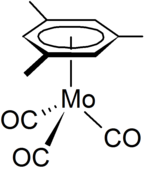有机钼化学
有機鉬化學,是一門專門研究包含碳-鉬鍵的化合物(有機鉬化合物)的化學的學科,是有機金屬化學的分支。鉬、鎢這些較重的6族元素會生成與有機鉻化合物相似的有機金屬化合物,但通常鉬與鎢會有更高的氧化數。[1]
Mo(0)或更低價態的化合物[编辑]
於六羰基鉬中,鉬是零價的,是很多衍生物的前體。它可以跟有機鋰試劑反應,生成酰基陰離子(anionic acyls)。此陰離子可以發生O-烷基化反應,生成Fischer卡賓。此外,六羰基鉬可以跟芳烴反應,生成具有鋼琴凳(piano stool)幾何構型的配合物,例如均三甲苯三羰基鉬。環庚三烯三羰基鉬可以跟三苯甲烷的鹽反應,生成環庚三烯基配合物。[2]反應式如下:


六羰基鉬可被還原,生成 [Mo(CO)5]2−,其中鉬為負二價。[3] 不含CO的零價鉬化合物比羰基化合物更具還原性,在動力學上亦更不穩定。[4]
Mo(II)的化合物[编辑]
六羰基鉬的鹵化可製備鉬羰基鹵化物,它也可以用來製備其他化合物。[5]同時,六羰基鉬和乙酸反應可以得到乙酸鉬(II),反應中羰基被乙酸根取代,放出一氧化碳,鉬從零價氧化至正二價。[6][7]反應式如下:
Mo(IV)的化合物[编辑]
Mo(V)、Mo(VI)的化合物[编辑]
、以及是已知的物種。[8]
用於烯烴複分解反應的施羅克催化劑内含Mo(VI)。[9]然而,用施羅克標準的方法來製備這些催化劑是有問題的。下圖的物種17在室溫下是活潑的。[10]

原本設計用來計量裂解氮的相關前體18有更多用途。[11][12]實際上,當配合物18與二氯甲烷在甲苯中作用,主要生成配合物19與20。[13]而當配合物18跟1,1-二氯乙烷反應,胺等極性基團可被運用,而這些基團是可以鈍化具有路易斯酸性的配合物,如 Schrock 配合物。基於這發現,Moore 和其他人嘗試以其他偕二氯烷烴作活化劑,以延長這些催化劑的壽命。[14]加入鎂金屬可以將副產物氯化物重新轉化為反應物。同時,以對硝基苯酚等缺電子的配體取代原先配體,可以得到一個非常活潑的催化劑22。它在很多範疇都非常有效,尤其是在聚合物化學與材料科學兩個領域。[15]此外,以三齒配體醇解配合物21,可延長化合物的壽命,亦可擴濶可用受體的範圍。[16]
但即使配合物18有很多好處,它其實不僅對氧化與水解敏感,而且非常活潑,連氮氣分子都可以裂解,因此要小心使用。

應用[编辑]
有機鉬化合物是可用作烯烴複分解[17]、炔烴複分解反應[18]的催化劑。

在考夫曼烯化反應中,三氯化鉬與甲基鋰反應生成一個配合物,將醛、酮轉變為亞甲基烯烴。[19]

參考資料[编辑]
- ^ Poli, R. High oxidation state organomolybdenum and organotungsten chemistry in protic environments (PDF). Coord. Chem. Rev. 2008, 252 (15–17): 1592–1612 [2022-08-29]. doi:10.1016/j.ccr.2007.11.029. (原始内容存档 (PDF)于2022-02-06).
- ^ Green M. L. H., Ng D. K. P. Cycloheptatriene and -enyl Complexes of the Early Transition Metals. Chemical Reviews. 1995, 95 (2): 439–73. doi:10.1021/cr00034a006.
- ^ Ellis, J. E. Metal Carbonyl Anions: from [Fe(CO)4]2− to [Hf(CO)6]2− and Beyond. Organometallics. 2003, 22 (17): 3322–3338. doi:10.1021/om030105l.
- ^ Flower, K. R. Molybdenum Compounds without CO or Isonitrile Ligands. Mingos, D. Michael P.; Crabtree, Robert H. (编). Comprehensive Organometallic Chemistry III 5: 513–595. 2007. ISBN 9780080450476. doi:10.1016/B0-08-045047-4/00072-8.
- ^ Joseph L. Templeton "Four-Electron Alkyne Ligands in Molybdenum(II) and Tungsten(II) Complexes" Advances in Organometallic Chemistry 1989, Volume 29, Pages 1–100.doi:10.1016/S0065-3055(08)60352-4
- ^ Brignole, Alicia B.; Cotton, F. A.; Dori, Z.; Dori, Z.; Dori, Z.; Wilkinson, G. Rhenium and Molybdenum Compounds Containing Quadruple Bonds: 81–89. 2007. ISSN 1934-4716. doi:10.1002/9780470132449.ch15.
- ^ Pence, Laura E.; Weisgerber, Amy M.; Maounis, Florence A. Synthesis of Molybdenum-Molybdenum Quadruple Bonds: A Multistep Advanced Synthesis Laboratory Experiment. Journal of Chemical Education. 1999, 76 (3): 404. ISSN 0021-9584. doi:10.1021/ed076p404.
- ^ Flower, K. R. Molybdenum Compounds without CO or Isonitrile Ligands. Mingos, D. Michael P.; Crabtree, Robert H. (编). Comprehensive Organometallic Chemistry III 5: 513–595. 2007. ISBN 9780080450476. doi:10.1016/B0-08-045047-4/00072-8.
- ^ R.R. Schrock. High-oxidation-state molybdenum and tungsten alkylidene complexes. Acc. Chem. Res. 1986, 19 (11): 342–348. doi:10.1021/ar00131a003.
- ^ Tsai, Yi-Chou; Cummins, Christopher C. Facile Synthesis of Trialkoxymolybdenum(VI) Alkylidyne Complexes for Alkyne Metathesis. Organometallics. 2000, 19 (25): 5260 [2022-08-30]. doi:10.1021/om000644f. (原始内容存档于2022-02-06).
- ^ Cummins, Christopher C. Reductive cleavage and related reactions leading to molybdenum–element multiple bonds: new pathways offered by three-coordinate molybdenum(III). Chemical Communications. 1998, (17): 1777–1786 [2022-08-30]. doi:10.1039/A802402B. (原始内容存档于2022-06-20).
- ^ Fürstner, Alois. Mo[N(t-Bu)(Ar)]3 Complexes As Catalyst Precursors: In Situ Activation and Application to Metathesis Reactions of Alkynes and Diynes. J. Am. Chem. Soc. 1999, 121 (40): 9453 [2022-08-30]. doi:10.1021/ja991340r. (原始内容存档于2022-09-26).
- ^ Agapie, Theodor. Methine (CH) Transfer via a Chlorine Atom Abstraction/Benzene-Elimination Strategy: Molybdenum Methylidyne Synthesis and Elaboration to a Phosphaisocyanide Complex. J. Am. Chem. Soc. 2002, 124 (11): 2412–2413 [2022-08-30]. PMID 11890770. doi:10.1021/ja017278r. (原始内容存档于2022-02-06).
- ^ Zhang, Wei; Moore, Jeffrey. Highly Active Trialkoxymolybdenum(VI) Alkylidyne Catalysts Synthesized by a Reductive Recycle Strategy. J. Am. Chem. Soc. 2004, 126 (1): 329–335 [2022-08-30]. PMID 14709099. doi:10.1021/ja0379868. (原始内容存档于2022-09-24).
- ^ Zhang, Wei; Moore, Jeffrey. Synthesis of Poly(2,5-thienyleneethynylene)s by Alkyne Metathesis. Macromolecules. 2004, 37 (11): 3973 [2022-08-30]. Bibcode:2004MaMol..37.3973Z. doi:10.1021/ma049371g. (原始内容存档于2022-02-06).
- ^ Zhang, Wei. Introducing A Podand Motif to Alkyne Metathesis Catalyst Design: A Highly Active Multidentate Molybdenum(VI) Catalyst that Resists Alkyne Polymerization. Angew. Chem. Int. Ed. 2011, 50 (15): 3435–3438 [2022-08-30]. PMID 21394862. doi:10.1002/anie.201007559. (原始内容存档于2022-02-06).
- ^ R.R. Schrock. High-oxidation-state molybdenum and tungsten alkylidene complexes. Acc. Chem. Res. 1986, 19 (11): 342–348. doi:10.1021/ar00131a003.
- ^ Wei Zhang; Yunyi Lu; Jeffrey S. Moore. Preparation of a Trisamidomolybdenum(VI) Propylidyne Complex. Org. Synth. 2007, 84: 163. doi:10.15227/orgsyn.084.0163.Wei Zhang; Hyeon Mo Cho; Jeffrey S. Moore. Preparation of a Carbazole-Based Macrocycle via Precipitation-driven Alkyne Metathesis (PDF). Org. Synth. 2007, 84: 177. S2CID 93992722. doi:10.15227/orgsyn.084.0177. (原始内容 (PDF)存档于2020-02-19).
- ^ Kauffmann, T. Organomolybdenum and organotungsten reagents. 7. Novel reactions of organomolybdenum and organotungsten compounds: additive-reductive carbonyl dimerization, spontaneous transformation of methyl ligands into μ-methylene ligands, and selective carbonylmethylenation. Angew. Chem. Int. Ed. Engl. 1997, 36: 1259–1275. doi:10.1002/anie.199712581.
參見[编辑]
| ||||||||||||||||||||||||||||||||||||||||||||||||||||||||||||||||||||||||||||||||||||||||||||||||||||||||||||||||||||||||||||||||||||||||||||||||||||||||||||||

![{\displaystyle {\ce {(C7H8)Mo(CO)3 + (C6H5)3C+ -> [(C7H7)Mo(CO)3]+ + (C6H5)3CH}}}](https://wikimedia.org/api/rest_v1/media/math/render/svg/05eb6648eab06c5841495f4b20475e0ccc7ace91)

![{\displaystyle {\ce {Li4[Mo2(CH3)8]}}}](https://wikimedia.org/api/rest_v1/media/math/render/svg/aa5d9fa47a6fc96022cad5512b78fa85e6a93f8b)


![{\displaystyle {\ce {[Mo(CH3)7]^-}}}](https://wikimedia.org/api/rest_v1/media/math/render/svg/ad8de13e657f2fa3875798f5793d289427bf025b)